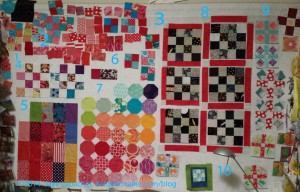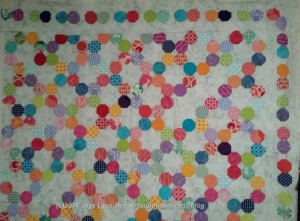 The Bag Making Bible by Lisa Lam
The Bag Making Bible by Lisa Lam
My rating: 3 of 5 stars
I have an idea to make the perfect work bag. I haven’t yet found a pattern out there, but with the right knowledge of techniques and an ok pattern, I can probably make something that will work.
After reviewing Big City Bags by Sara Lawson, I put the book in my database (I am a librarian after all!). In the course of testing the records and the search results, I came across Lisa Lam’s The Bag Making Bible and had to look through it for more ideas.
If you have this book and Big City Bags, you have everything you need to make almost any bag out there. Big City Bags by Sara Lawson has good techniques, but is mostly a project book. Lisa Lam‘s book focuses more on techniques, but has projects to go with each technique. The projects are not the focus of the book. In fact they are even hard to find, hidden as they are in the midst of detailed instructions for techniques.
One of the different aspects of this book is that the techniques build on each other. This is a more down and dirty, ‘here’s everything you need to know’ kind of book than Big City Bags. It goes from very basic (explaining parts of the sewing machine-pg.14) through intermediate (explaining a pattern with a glossary of terms) to advanced (modifying patterns). You will have to think, because skills or techniques you learn in one section are referred to again in another section.
On careful examination of the table of contents, I saw that the projects were, indeed, named and given a page number as a subheading under the main point/heading of the chapter. I like this idea, because by scanning the list of techniques, I can find projects that will illustrate the technique I want to learn.
The book is laid out in a pretty standard way: Table of Contents, Foreword and Introduction. The introduction has one line that explains the premise of the book “I have purposefully moved away from quick and easy bag projects because I believe that when you spend a little more time in creating something special you will cherish the results all the more.” This is a great description of the premise of the book.
The first sections after the above are all about the basics. They start with Basic Equipment. The author has good photos of the basic equipment, some of which I have never seen in a bag book. I like it that these unusual tools are included. I did wonder why no rotary ruler was included in the list, though a rotary cutter is included.
The sewing machine section includes some information on machine stitches and photos of the machine feet.
The next section is called Anatomy of a Bag, which covers all the aspects of a bag from parts you have heard of like flaps to parts like the gussets, which are less common.
The basics continue with ‘Getting Started’, which discusses using patterns, ‘Understanding Patterns’,’Fabric Preparation and Cutting,’ Modifying Patterns and then the book continues on to the techniques and projects. The ‘Understanding Patterns’ section is good also for garment sewing.
‘Choosing Fabrics’ is very complete. It includes a description of different types of fabrics and the pros and cons of each. The section talks about how best to use the fabrics for bags. This section has a subsection on choosing interfacing and interlining. Again, there are descriptions and definitions of different types and weights of interfacing.
I like the section called ‘Working with Colour and Pattern.’ The author has some beginner level suggestions. While there is no color wheel, the section gives the reader some suggestions about choosing colors as well as using pattern/motifs.
This is where the projects come in. The techniques are all associated with projects and the project teaches the reader those associated techniques. For example, in the Structure and Reinforcement section, there is a chart of ‘Volume Adding Features’. These are darts, pleats, etc and the chart tells the reader the benefits and suggested uses of each. The project photos have good detail shots and lots of instructions which, together, help understand how to use the featured technique while putting the project together.
The book has sidebar boxes throughout the book. The color and pattern section has boxes about using texture and sourcing fabrics. Some of the sections have a ‘Need to Know’, which covers important concepts that don’t fit into the other text.
I like the section on ‘Linings.’ It includes a chart of different types of pockets (charts are a good way to get a lot of information across quickly) as well as photos of the linings.
As with Big City Bags, zippers are covered really well. This book helps me understand what Sara Lawson was doing when I followed the directions for her Flush Zipper Pocket on the Petrillo Bag pattern. I was able to make the pocket from Sara’s excellent directions, but didn’t understand the underlying concept until I read this book. This is a great example of why these two books work really well together.
Information about zippers leaks over into the section called ‘Closures.’ Again, Lam includes a chart of different types of closures with benefits and suggested uses. There are photos different types of closures and how to insert them. I really liked the instructions on adding a pull tab to a zipper. This would have really helped me in some projects I have made recently.
Different types of trim, such as tassels, and edgings, such as piping, are also covered. Ready made handles and the different types of pockets that can be used are defined and instructions are provided.
I do think this book, and most bag books, could have benefited more from photos of the inside of the bags. I thought this, especially, when I saw The Organized Office Bag project. There are plenty of gorgeous pictures of the outside, but, frankly, the inside is heart of the matter for me. How many pockets are there?
This is a comprehensive book and would be a great addition to any bag maker’s library. It is a necessity for anyone who wants to understand bags and their components to an extent of designing or modifying patterns.
View all my reviews













